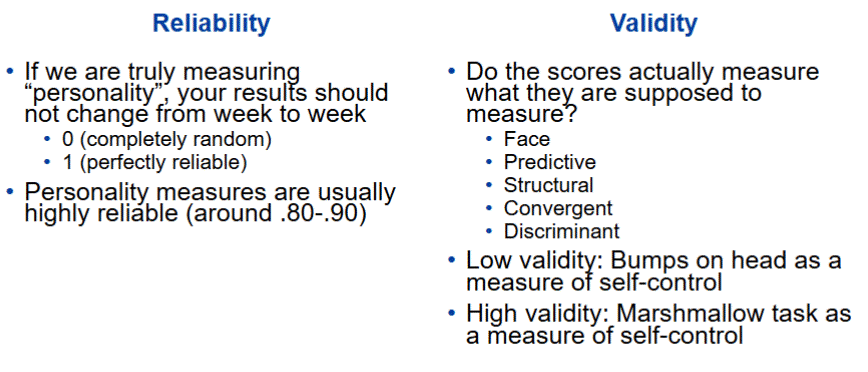Psych 150 Lecture 3 (Personality assessment and judgement)
1/11
There's no tags or description
Looks like no tags are added yet.
Name | Mastery | Learn | Test | Matching | Spaced |
|---|
No study sessions yet.
12 Terms
non scientific methods
Astrology
• Personality assessment based on birth date
Physiognomy
• Personality assessment based on shape of body, particularly the face
Phrenology
• Personality assessment based on morphology (shape) of skull
Myers-Briggs (MBTI)
Enneagram
why non scientific methods are no valid
• Not developed scientifically
• Not reliable...
- 50% of people get a different score/type when they re-take the test a few weeks later (score shouldn’t change drastically)
• Not much evidence for predictive validity
- Scores do not predict health, happiness, job performance, and other life outcomes
• All dimensions are positive (not all dimensions are positive)
• Assumes personality falls into categories
- You’re either an extravert or an introvert (though, in actuality, most people fall in the
middle)===very black and white makes u make a forced choice
• Use of types is problematic (promotes categorical thinking)
• The Barnum Effect
- Summaries of “types” often have generalized statements or events that people
naturally assign to themselves and give specific meaning
landmarks in personality assessment
• Projective tests*
- 1920-30s Rorschach and TAT (meaningless inkblot test) reveals something abt personality
• “Objective” tests (measures w intent)
- 1943 Minnesota Multiphasic Personality Inventory (MMPI)
- 1956 California Psychological Inventory (CPI)
- 1980s NEO-Personality Inventory (NEO-PI)
- 1990s Big Five Inventory (BFI)
- 2000s
- Electronically Activated Recorder (EAR)
- Data mining (e.g., Instagram, Facebook)
- McAdams Life Story Interview
most commonly used measures
Big Five personality traits
• NEO-Personality Inventory (NEO-PI)
• Big Five Inventory (BFI)
Life Narratives
• McAdams Life Story Interview
Measures for one construct
• Rosenberg Self-Esteem Scale
• Dispositional Optimism Scale
• Self-Control Scale
All developed through rigorous psychometric approaches
self report items
Transparent
• “If I ruled the world it would be a much better place”
Non-transparent
• “People pretend to care more about one another than they really do”
• “I used to like hopscotch” [low]
features of scientific personality assessments
• Captures thoughts, feelings, AND behaviors
• Assessed on a continuum – NOT categories or types
• Assesses both positive and negative dimensions of personality
• Aims to know what you are like in general
• Reliable
• Valid
features of scientific personality assessments: reliability and validity

personality judgement
Everyone does it. ALL the time.
• Who am I? Who is.... my best friend, the barista at the coffee shop, my brother, my classmate, my cat?
These judgments can have important consequences
• Opportunities
• Employment
• Relationships
• Expectancies/self-fulfilling prophecies
accuracy
What criteria can be used to assess accuracy of personality judgments?
Depends on who you ask!
• Answer from constructivism: none; personality is a social construction
• Answer from critical realism: all information that might be helpful
Possible criteria for determining accuracy
• Convergent validity
• The “duck test”
• Interjudge agreement
• Behavioral prediction and predictive validity
First impressions
**w/in culture have a degree of accuracy (different in every culture obvs)
Mostly automatic
We use visible (non-verbal) information such as:
• Face
• Clothes
• Belongings
• Eye contact
We use verbal cues such as:
• Gestures
• Storytelling
• Musical preferences
• How loud you talk
• Affect expression
how much info do do you need
More information is usually better, especially for some traits
The longer you know someone, the more accurate you are
• BUT even 5 min of interacting with a stranger is almost just as “accurate” for predicting behavior as a well-informed judge!
The information needs to be of good quality
• E.g., weak versus strong situations
who makes a good judge and target
• Good judges tend to be socially skilled, open minded, well- adjusted, and attributionally complex
• Being a good judge is beneficial!
• People vary in the extent to which they can be accurately judged (aka judgability)
• Good targets tend to be well-adjusted, behaviorally consistent, extraverted, agreeable, and healthy